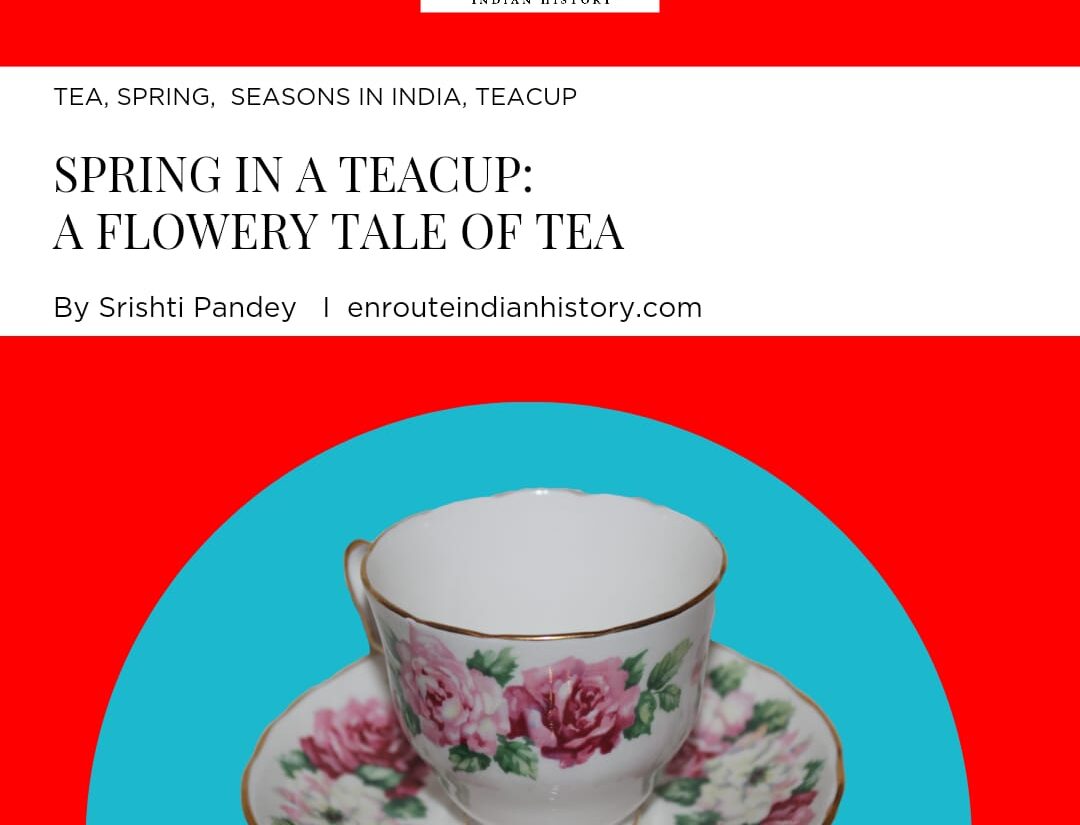
Tea is considered to be the second most popular non-alcoholic beverage in the world. The British introduced tea in India and today it has become the lifeline for many people in the country. Tea is a staple drink in most Indian homes and one turns to tea for warmth, comfort and also as a conversation starter. From cardamom (elaichi), adrak (ginger) and masala tea, these are also perfect companions for research. Holding a cup of tea is like holding the hand of a friend who always makes one feel better.
The receding winters and the warmth of spring is the perfect time to explore the colorful world of floral teas. Made from some of the most beautiful and beneficial spring flowers, the floral teas are also known as Tisane and they are prepared from different parts of a plant. Being caffeine free also has made these Indian teas popular in today’s times. The tea is prepared by adding flowers to either black or green tea and these are enjoyed both as a hot and a cold beverage.
The floral teas have also been referred to as experience teas. The teas made from the beautiful Indian spring flowers are great options to serve to the guests. These can also be considered as a great option for the afternoon tea sessions and are also known as blossoming teas.
The wide ranging flowering teas are made from a variety of Indian flowers such as Hibiscus, Aparajita, Rose, Lavender amongst others. The floral teas are also flavored by adding spices and herbs. There are some floral teas which do not have a specific taste and then there are teas which have a distinct flavor attached to them, for example Rose. There are limitless ways in which the floral teas can be created and these variations are usually the brainchild of the tea master (someone who meticulously curates, blends and then brews the tea to be served and the tea master even makes innovations in the tea blends).
It is believed that the floral teas were originally crafted in China and served to the royalty there. Even before the advent of the British, the yogis in India made tea with spices, herbs and flowers. The tea produced from the Indian flowers may be blended with a base which may be black tea, green tea or white tea and this then makes the floral teas caffeinated. Some of the classical blends which may be considered to be good combinations are a blend of black and lavender tea and rose paired with white tea.
India also has had a rich history of floral teas which are made from the popular Indian spring flowers. The floral teas made with the Indian flowers are a beautiful blend of color and good health and some of the popular ones are Blue Pea Tea, Rose Tea, Lavender Tea, Hibiscus Tea, Chamomile Tea amongst others.
-
BLUE TEA:
The blue tea is also called the Blue Pea Tea. The Indian flower used in this cup of tea is the Aparajita flower. Post the brewing process the tea produces a lovely blue color and the flavor of this tea is floral and mildly sweet. A fascinating feature of this tea is that it becomes purple when lemon is squeezed in it. Naturally free from caffeine, this tea has health benefits which make it high in antioxidants and this tea may also help prevent inflammation. It is even said to protect against type two diabetes, cancer and even heart diseases. This tea has also been credited with benefiting memory and helps with brain health.
The Indian Flowers which are used to make this blue tea are native to the taste of Assam and when translated the Aparajita signifies invincibility. This Indian flower is also considered sacred in the Hindu tradition. The blue tea can be served both hot and cold.

Exhibit 1: Blue Tea
The Blue tea is said to be beneficial for weight loss and helps in burning calories. It even aids the detoxification process in the body. The floral tea is pyretic in nature and helps in bringing down the fever. It is also considered as a stress reliever and it even promotes good sleep. Research has shown that the tea helps in slowing the digestion of carbohydrates in the body and that is said to be beneficial for the people who suffer from diabetes.
-
ROSE TEA:
Roses have expressed love and have played an important role in herbal medications as well. From being used in sharbat (squashes) to being used to decorate the Indian sweets, this Indian flower has today come to be a popular choice for floral Indian teas. Roses are an essential part of the Spring tradition in the country. Both the rose petals and rose hips are used to make floral teas with this beautiful Indian flower. The rose petals provide a floral note to light and mellow teas, while the rosehips add sweetness and tartness to the fruit flavored blends. All the roses are edible in nature and can be used to make teas. The Indian tea made using the rose petals are said to provide relief from stress and anxiety. It is even considered to be an aid for a good sleep. The rose petal teas also are considered to having mild laxative qualities and aid digestion. This tea is also said to be a reliever in the menstrual cramps. The rose petals have antioxidant properties and the antimicrobial qualities help in preventing bacterial infections. The tea increases hydration and even takes credit for soothing inflammation.

Exhibit 2: Rose Tea
The rosehips are sweet and tart and their taste is a lot like the cranberry fruit. The health benefits which have been attributed to the rose petals tea and the rosehip tea are very similar. There is however one benefit which has been attributed to the rosehip tea. It is high in vitamin C which helps in boosting the immunity and the absorption of iron.
-
LAVENDER TEA:
This is a popular floral tea. On its own, lavender is very strong and it cannot be used as a single ingredient in a tea. Therefore it is added to tea blends and it helps in imparting a fruity flavor to the tea. The health benefits of lavender essential oils have been known and studied. The Lavender flower is grown in Kashmir. It takes time to get accustomed to the taste of this Indian flower’s tea. However when one starts appreciating the taste this Indian flower’s tea helps in fighting fatigue, and it is said that it assists in lifting the mood of the person as well.
Even the fragrance of this tea is said to have a soothing effect on the consumer. It is believed that Lavender tea also has a soothing effect on menstrual cramps. The tea also soothes headaches and migraines and it is said to boost the immune system as well.

Exhibit 3: Lavender Tea
Since lavender tea is had as a blend of different teas some of the popular blends are Early Grey Lavender Tea (Earl Grey has a citrus flavor and Lavender adds a floral note to the tea. Lavender is also sometimes mixed with sleep inducing and relaxing ingredients such as Chamomile, Calendula etc. when mixed with mint, it aids in digestion.
-
HIBISCUS TEA:
The Hibiscus is a popular Indian flower and is amongst the most beautiful Spring flowers in India. Originating in North Africa and South East Asia, these flowers have contributed towards the beauty of gardens and homes as well. The Hibiscus tea is made from the dried parts of the Hibiscus plant and this provides the tea with a deep red color. The flavors in this tea are sweet and tart and that makes it similar to the flavors of cranberry. The dried petals of the Hibiscus flower which elevates the beauty of the spring season are made from the dried petals of the Hibiscus plant. These lovely spring flowers also help in adding color and taste to other varieties of herbal teas. This cup of tea can be enjoyed both as a hot beverage or as an iced tea. This flavourful cup of tea made with this Indian flower is said to be beneficial for the health of the consumer. It helps in cooling the body temperature, being high in antioxidants, this Indian tea is said to assist in cell growth.

Exhibit 4: Hibiscus Tea
The spring flower of Hibiscus is considered as a great source of iron and this helps in improving the energy levels in the body. It provides a boost to the immune system. It is considered to be helpful for menstruating women especially the ones who suffer from the loss of iron. Hibiscus tea is also rich in vitamin C and that helps in the iron absorption and the healing of wounds. This Indian tea has also been studied to show that it helps in the reduction of blood pressure. This tea has also been credited with doing wonders to hydrate the skin and it provides vital nutrients for the growth of the skin. This floral cup of tea helps in boosting the metabolism and it even helps in maintaining a healthy weight. This Tea however may be avoided by pregnant women and lactating mothers as it has estrogenic properties present in it.
-
CHAMOMILE TEA:
Chamomile is considered to be one of the oldest medicinal herbs. This Indian flower is grown in Uttarakhand (in the ridge near Ranikhet) and even in Dharamshala. This Indian flower is also grown in the Kumaon in the Himalayas. Chamomile keeps producing flowers every three months and that is helpful for the farmers to maintain a regular income.
This floral tea is a cup of benefits. It contains Flavonoids and these add the health benefits to the tea. This Indian flower is said to provide relief from premenstrual syndrome. Chamomile tea is one of the Indian flowers which when consumed in the form of tea may reduce the blood sugar levels as it may improve the glycaemic and lipid profiles.

Exhibit 5: Chamomile Tea
A study from the Multidisciplinary Digital Publishing Institute highlighted how the Chamomile tea may have the power to target the cancer cells. It is believed that even their development can be prevented. It has been credited by the tea consumers as having a positive effect on them as it helps in reducing their anxiety, thereby helping them sleep better. However it is advisable for pregnant women to avoid the consumption of this tea.
The floral teas are a colorful and flavourful blend of health and happiness. However it is advisable that before consuming the herbal teas one may consult a healthcare professional. The spring season is an appropriate time to bring the Indian flowers to our teacups through these colorful Indian teas.
REFERENCES:
- https://www.healthline.com/nutrition/rose-tea#hydration-weight-loss
- https://artfultea.com/blogs/wellness/types-of-herbal-tea-and-their-benefits
- https://artfultea.com/blogs/wellness/flower-power-rose-tea-benefits
- https://artfultea.com/blogs/wellness/lavender-tea
- https://bluetea.co.in/blogs/news/what-india-used-to-drink-as-tea-before-british-arrived
8.https://www.realsimple.com/health/mind-mood/emotional-health/chamomile-tea-benefits
- https://rosaholics.com/blogs/rosaholics-bloggers/rose-tea-recipe
- https://www.healthline.com/nutrition/5-benefits-of-chamomile-tea
- https://www.firebellytea.ca/blogs/all/lavender-tea-health-benefits


















